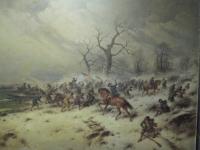In 1775, the American Revolutionary War began in the British colonies on the Atlantic Coast of North America. Eight years later, these colonies won their independence from Great Britain, forming the United States of America. Despite the end of the war, the idea of independence has endured and evolved, becoming part of the American psyche. The Museum of the American Revolution, expected to open in Philadelphia in late 2016, will focus on the history of the rebellion of the North American colonies against British rule, providing visitors with insight into the lives of those who influenced and experienced the Revolution and those whose lives were affected by it. The Museum will also document the development and evolution of the idea of independence in the United States over time. We had the pleasure of surveying the Museum's archival collection earlier this month.

A ticket for the Philadelphia and Worcester Lottery, 1769
In addition to its several thousand objects and artworks, the Museum of the American Revolution also has an archival collection of manuscripts and printed materials. The core of the Museum’s archival collection, circa 1730-1977, contains materials from the Revolutionary War era (1775-1783). Other documents in the collection date from both before and after the War, providing context about the period leading up to the War and documenting its aftereffects, including the lives of veterans, commemorations of soldiers and of Revolutionary sites such as Valley Forge (Pennsylvania), and other related topics.

Visitors outside of Washington's Headquarters in Valley Forge, 1904
Items in the collection include letters, financial documents, muster rolls, military commissions, photographs, property-related documents, and a variety of other primary source materials. A number of the letters in the collection concern military matters during the American Revolution. Of special interest are a number of orderly books from Valley Forge, 1777-1778. Several documents in the collection are from or related to various prominent historical figures, including George and Martha Washington and their descendants, Baron Friedrich von Steuben, Patrick Henry, Thomas Jefferson, the Marquis de Lafayette, and more. There are also a number of printed materials (largely from the Colonial/Revolutionary era) including newspapers, ephemera, lithographs, and pamphlets.

A French passport signed by King Louis XVI and Charles Gravier, comte de Vergennes, the Foreign Minister of France, 1782

Valley Forge orderly book, 1778


A letter from General George Washington at his headquarters in Valley Forge, Pennsylvania to Patrick Henry, Governor of Virginia, regarding the returns of the Virginia regiments, January 3, 1778
Even though the Museum of the American Revolution is not yet built, its treasure trove of colonial, Revolutionary War, and post-Revolutionary War archival materials is something you won't want to miss if you’re interested in the Revolutionary War era or the concept of independence in the United States.

